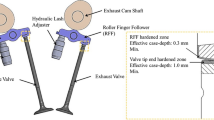Abstract
Thermal fatigue phenomenon of internal combustion engine valve seat insert (VSI) is discussed. Metallographic, microhardness mapping, and fractographic-assisted examinations along with residual stress analysis have exhibited basic characteristics of VSI thermal fatigue cracking. Based upon the results from dynamometer engine tested parts examination, the mechanism of VSI thermal fatigue crack initiation and propagation has been established. It is revealed that the propensity of a VSI thermal fatigue crack formation is related to physical and mechanical properties of VSI alloy, solidification substructure, and temperature gradient in VSI under an engine run operation condition. The assessment concept of thermal fatigue crack resistance of a VSI in this study can be adopted for engine VSI design and materials failure analysis applications.






Similar content being viewed by others

References
US Patent 6,702,905, Corrosion and Wear Resistant Alloy, March 9th, 2004
US Patent 8,479,700, Iron Chromium Alloy with Improved Compressive Yield Strength and Method of Making and Use Thereof, July 9th, 2013
J.P. Holman, Heat Transfer, McGraw-Hill Book Company, Copyright © 1981, ISBN 0-07-029618-9, New York, USA, 1981
G.E. Dieter, Mechanical Metallurgy, the Third Edition, copy right © 1986, McGraw-Hill Series in Materials Science and Engineering, New York, USA, 1986
R.W. Hertzberg, Deformation and fracture mechanics of engineering materials, copy right © 1976, 1983. (Wiley, New York, 1989)
D.R. Jones, “Fatigue Behavior of Exhaust Valve Alloys,” SAE technical paper 800315, Copyright © 1980 SAE, Inc., Warrendale, PA 15096, February 1980.
ASTM Standard E466 – 07, “Standard Practice for Conducting Force Controlled Constant Amplitude Axial Fatigue Tests of Metallic Materials,” Annual Book of ASTM Standards, Volume 03.01, pp. 587 – 608, West Conshohocken, PA 2014
C.P. Qiao, “Thermal fatigue cracking tendency in Alloy J153 VSI During an Abuse Dynamometer Engine Test,” L.E. Jones Company Materials Engineering Report, L.E. Jones Company, Menominee, MI 49858, May 2011
Acknowledgments
This study has been carried out at and sponsored by L.E. Jones Company through L.E. Jones Company R&D Program.
Author information
Authors and Affiliations
Corresponding author
Additional information
Publisher's Note
Springer Nature remains neutral with regard to jurisdictional claims in published maps and institutional affiliations.
Rights and permissions
Springer Nature or its licensor (e.g. a society or other partner) holds exclusive rights to this article under a publishing agreement with the author(s) or other rightsholder(s); author self-archiving of the accepted manuscript version of this article is solely governed by the terms of such publishing agreement and applicable law.
About this article
Cite this article
Qiao, C.P. Thermal Fatigue Cracking Phenomenon in Engine Valve Seat Insert. J Fail. Anal. and Preven. 23, 2640–2647 (2023). https://doi.org/10.1007/s11668-023-01793-7
Received:
Accepted:
Published:
Issue Date:
DOI: https://doi.org/10.1007/s11668-023-01793-7



